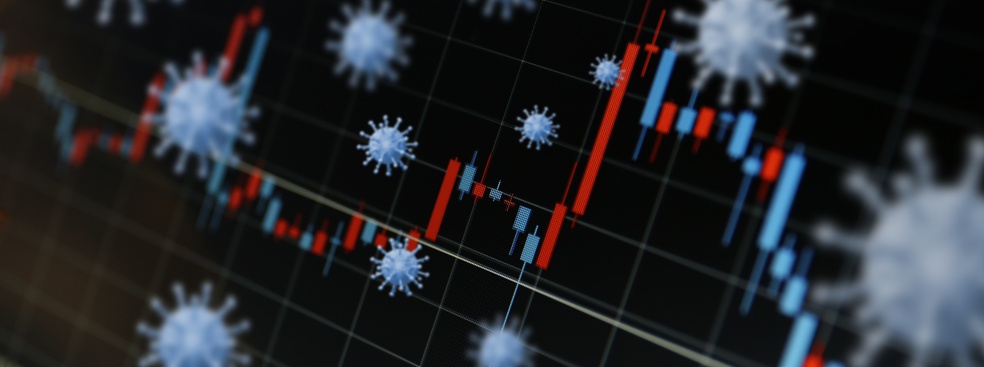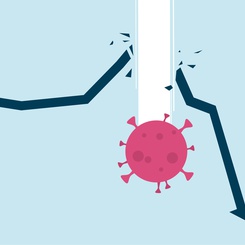Surprising as it may seem, the COVID-19 epidemic and the subsequent economic crisis have more in common than meets the eye. How so? The market economy is a living organism, made up of a myriad of firms able to adapt or die under duress. The price system is the nervous system of the market economy, conveying the information about shocks to individual decision makers that adapt their behavior.
The first wave of the COVID-19 pandemic that started in late 2019 in Wuhan, China and then spread globally has devastated the planet. On June 29th, 2020, the Johns HopkinsCoronavirus Research Center counted 502 000 deaths and over 10.1 million confirmed cases worldwide. At that time, the pandemic appeared to be under control in Europe and Asia, and was still expanding in the United States and South America.
The pandemic has led to a major economic crisis. The June 2020 forecasts of the International Monetary Fund and OECD depict a post-apocalyptic world. According to the IMF, the world economy will contract by 4.9% in 2020. The advanced economies will fare the worst, the Euro area could contract by 10.2%, and the US by 8% (see IMF 2020). Underemployment could reach historical heights by the end of 2020, be it in the form of classical unemployment or hidden by “partial activity” schemes (Kurtzarbeit). World trade is expected to fall by 11.2% according to the FMI or 13% according to the WTO (2020).
What parallels can we draw between the pandemic and the subsequent economic crisis?
The SARS-CoV-2 virus at the origin of the COVID-19 pandemic is a puzzling virus. While its structure is simple and belongs to a class of pathogens well known to researchers, its infectiousness was extremely difficult to gauge due to the large number of asymptomatic cases and scarce reliable tests. The amount of infected people that would need to be hospitalized and require a respirator was also difficult to anticipate. Even now, as the first wave subsides in many places and tests are more widely available, experts are still debating the key parameters of the pandemic (Adam, 2020). One consequence of this uncertainty was the early publication of apocalyptic scenarios. An influential report by the Imperial College Faculty of Medicine on March 16th claimed that 500 000 UK residents and 2.2 million US residents would die if no action is taken. These dire forecasts prompted governments all over the world to impose harsh lockdowns. The cases of Sweden, Japan, and South Korea, who adopted a more hands-off approach, showed that these forecasts were probably exaggerated.
When it comes to the economic crisis, the basic ingredients are well known to researchers. The global economy has often been hit by major demand shocks that it has sometimes had to manage with supply shock. However, the combination of the two types of shocks is disturbing the paradigms on which standard forecasting models are built. Sailors know that the most dramatic risks happen not when the ship sails the biggest waves, but when smaller waves cross each other. Because the economy is hit by an unprecedented combination of supply and demand shocks, the econometric models used by central banks and policymakers to forecast the dynamic of the economy could be as imprecise as the initial models used by the epidemiologists. In this crisis, the accuracy of the models depends first and foremost on their ability to correctly anticipate the response of the supply side (Baldwin, 2020).
In theory, if the economy is hit by a demand shock only, both output and prices collapse. If the economy is hit by an adverse supply shock, output collapses, yet prices might increase. The June 2020 forecasts by the ECB, the OECD and the IMF put significant weight on the decline in demand. Demand is expected to fall because of reduced consumption and investment as a result of uncertainty and fear; furthermore, the systemic nature of the crisis blocks the stabilization effect of international trade since all countries cut on imports simultaneously. If the contraction in GDP is driven by depressed demand only, a combination of fiscal and monetary stimuli could help with restoring growth without causing inflation.
However, if the COVID-19-induced supply shock is very strong, this is tantamount to a massive reduction in potential output. In this case, any attempt to foster demand in order to bring the GDP close to a pre-crisis level, above this potential output, would only bring about high inflation.
There are some possible explanations for why the supply shock might be both very severe and persistent. The supply collapsed during the lockdown period, since governments forced people to stay at home through several channels: closing firms and shops, banning travel and non-essential activities, banning meetings, closing schools which obliged parents to stay at home to do child care, and using fear-inducing communication in the media (death tolls, filming hospitals and patients, funerals, etc.). In some countries, essential activities were allowed, but fear and panic prevented people from working. If after mid-May most of these bans were removed in Europe, the supply shock did not vanish, as new sanitary protocols impose specific costs on firms. The opening of schools was relatively slow, and varied between countries; this maintains a relative shortage of the labor force in many sectors. Bans on international travel prevent temporary workers from participating in agriculture, particularly Western Europe, which has already led to higher food prices in June.
Another similarity is that both the virus and the economic consequences have been felt most strongly by certain groups. Older people are at a higher risk of passing away from COVID-19 (in Italy, of the 33.5k coronavirus deaths in June, more than 80% were aged 70 years and older). On the economic front, certain types of firms were also more at risk. Small firms seem to be more affected by the crisis than large firms. As the stock market in many countries has recovered, small cap indexes perform much worse than the large caps in June. If the crisis will lead to many small firms going bust, then the degree of concentration of the economies will rise. Against the background of increased protectionism, this would enhance the market power of large firms, and lead to higher profit margins, reversing a trend of growing competition in the global marketplace. An increase in the concentration ratio is also akin to lower potential output.
Furthermore, the risk of COVID-19 death is higher in the presence of another comorbidity factor, such as diabetes, hypertension, pulmonary diseases, or obesity. Similarly, companies that have already a weakness will be the first to go out of the market. The most prominent corporate comorbidity factor is massive short-term debt. Before the crisis, many companies were highly leveraged.
The OECD issued a strong warning in December 2019, revealing that the volume of corporate debt reached an historical high in real terms of USD 13.5 trillion at the end of 2019, and that the share of high-yield bonds was booming (OECD 2019). If the debt bubble had burst before the crisis, many of these highly leveraged firms would have collapsed.
The number of bankruptcies has been low so far because governments all over the world, in particular in Europe, placed distressed firms into a kind of artificial coma and kept pumping oxygen (cash) in their lungs (balance sheets). There is plenty of cheap money for firms to roll over their short-term debts, even for the high-yield market. Governments in the Euro area guarantee bank loans to firms at a low interest rate, and the ECB is sponsoring at negative interest rate commercial bank loans up to four years: in June, its net balance of long-term refinancing operations (LTROs) increased by 500 billion euros in one operation. In the US, the Fed (the US central bank) is also financing the private sector in a very aggressive and direct way by buying bonds and providing loans to distressed firms to the tune of hundreds of billion dollars (Powel, 2020). Both the Fed and the European Central Bank (ECB) reinstated massive quantitative easing programs through which they buy hundreds of billions of sovereign bonds (complete with all the tensions that move entails in the Euro area).
European governments also implemented massive employee furlough schemes, pioneered by Germany during the Global Financial Crisis of 2008 and reinstated now. This meant keeping workers on the payroll even if they work part-time, and the state pays their wages. This policy is useful for maintaining the work relationship, in particular for high qualified workers; on the other hand, it also camouflages the true number of underworked hours and might block much needed restructuring in those firms who would never fully recover.
Even before the recession, experts acknowledge the mounting numbers of so-called “zombie firms”, i.e. firms unable to pay their interest bills, kept alive only by revolving loans. Easy loans and employment furlough schemes only help maintain these firms. Unfortunately, if the sanitary costs must be maintained for a long period, and consumer spending behavior has changed forever, many other firms will join this fragile category.
This takes us to the last, and perhaps darkest, similarity. The sad truth is that many of the COVID-19 patients placed on respirators in ICUs did not recover, as their lungs were irreversibly damaged by the virus. When the artificial respirator was turned off, these people died. When the central banks and the government WILL cut their support to firms, these firms will go out of the market. It is normal to try to keep the firms alive until demand improves, and these firms can stand on their own feet. However, it would be a mistake to spend public money on firms that will never recover. The quicker such firms are restructured and employees can move into more profitable branches, the shorter the recession will be. Keeping workers on furlough schemes in firms that will never fully recover is a drag on productivity and prevents labor from moving to more useful activities, such as green energy. Unfortunately, it is currently almost impossible to sort out the solvent but illiquid firms from the simply insolvent ones. Some experts call attention to the risk that the massive numbers of expected bankruptcies could still entail a financial crisis in late 2020.
How is the world fighting the pandemic? While countries have now strengthened their hospitals by increasing the numbers of ICU spots and respirators available, the most critical move is get a vaccine as fast as possible. Because the structure of the virus is known, there is real hope that the vaccine could become available in a few months. Unfortunately, the parallel between the epidemic and the economy stops here, as there is no vaccine against the recession. Why can’t the government just keep on borrowing, and why can’t central banks just print more and more money (sometimes the same thing)? Well, they might, if investors keep on trusting them. Yet trust is a fragile asset. At the slightest sign of inflation, this trust could vanish, calling for austerity and restrictive monetary policies. Populist calls on defaulting on public debt will not help build trust in governments. In the Euro Area, tensions between Northern and Southern models, against the background of a proven superiority of fiscal and medical management by the North, might further undermine trust in the euro.
Fluctuations in economic activity are extremely painful for society. The burden of the adjustment often falls on less qualified workers and on low-income households. In the management of COVID-19, young people agreed to significant sacrifices to protect the elders, who were the most at risk from the virus. Hopefully the economic recovery will show a similar pattern, wherein the less affected categories will show the same degree of solidarity and will agree on sacrifices to protect the most affected firms or people.
To conclude, the two crises have shown that the market economy behaves as a living being, with the weaknesses and the strengths like those of mankind. In the free economy, curiosity, creativity, trust, and competitiveness back entrepreneurship and innovation. In turn, innovation drives growth and reduces poverty, as the decentralized price mechanism ensures the efficient allocation of resources, and norms and regulations allow corrections for externalities. If there is one way to successfully fight the pandemic, it is to trust that the bright minds in private firms, supported by researchers in academia and in private and public organizations, will find the best solutions (vaccine, drugs) as fast as possible, while respecting human rights and freedom.
References
Adam, D. Special Report: The simulations driving the world’s response to COVID-19. How epidemiologists rushed to model the coronavirus pandemic. Nature News Feature, April 3, 2020. Available at:https://www.nature.com/articles/d41586-020-01003-
Baldwin, R. 2020. The supply side matters: Guns versus butter, COVID-style, VOXEU, March 2020,https://voxeu.org/article/supply-side-matters-guns-versus-butter-covid-style
IMF, 2019, World Economic Outlook Update, A Crisis Like No Other, An Uncertain Recovery, IMF,June, Washington DC.,https://www.imf.org/en/Publications/WEO/Issues/2020/06/24/WEOUpdateJune2020
Powel, J. Coronavirus and CARES Act, Federal Reserve bank, June 30, 2020.https://www.federalreserve.gov/newsevents/testimony/powell20200630a.htm
OECD 2019, Corporate Bond Market Trends, Emerging Risks and Monetary Policy, OECD, Paris.http://www.oecd.org/corporate/corporate-bond-market-trends-emerging-risks-and-monetary-policy.htm
WTO 2020, Trade falls steeply in first half of 2020, WTO Press Release 858. https://www.wto.org/english/news_e/pres20_e/pr858_e.htm









